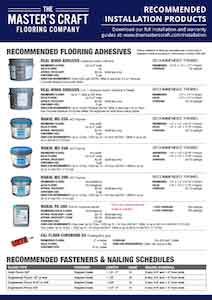If you’re involved in selling or installing hardwood floors, you have probably had to solve a “squeaky floor” problem for a customer.
Nobody likes it when their brand new hardwood floors start squeaking. Prefinished flooring manufacture warranties do not cover noise issues because they are job site related, and it can be a difficult problem to solve after installation. This creates headaches for everyone involved.
There are a few very easy things you can do to prevent the floors you are selling or installing from squeaking, and they won’t cost you much money. Following these best practices will keep your customers happy, and protect your reputation.
Start with a subfloor that doesn’t squeak
There aren’t many guarantees in life, but one you can count on is that if you have a squeaky subfloor, the wood flooring you install on top of it won’t magically fix it. Many squeaky wood floors aren’t actually the source of the problem – it’s the subfloor they are installed on top of that is the real issue.
Subfloors that are clean, dry, sound and flat will give you a great surface to work on and will be a great foundation for your wood flooring project.
Using the right fastener and nailing schedule won’t eliminate squeaks caused by a bad subfloor, as evidenced in a case documented by Wood Floor Business. Do the right thing and spend time looking at your subfloor and fixing any issues like high spots, squeaks, debris, deflection, or high moisture readings before you install your flooring.
Use the correct fastener for your wood floor

Perhaps the worst mistake you can make when installing a wood floor is using the wrong fastener or using the right one incorrectly. There’s no easy fix once it’s done. You can be sure it will cost far more to fix the problem of incorrect fasteners than it would to use the right tools from the beginning.
With so many different types of solid and engineered wood floors on the market, it’s important to know which products the manufacturer recommends to use for installation.
We have created a simple chart that shows the recommended installation material for each of our prefinished flooring collections. See all of our installation guides here.
If you are installing an unfinished wood floor, we can guide you to the correct fastener for your specific project. Contact one of our locations near you for a quote and a helpful answer to your fastener questions.
Use the right fastener in the right way
It’s not enough to use the correct fastener. You also need to use it the correct way – which means checking your compressor for the right pressure setting, and making sure your pneumatic gun is setup correctly.
Here is what can happen if you don’t use the correct fastener the right way:
Breaking the tongue on the flooring boards
Cause: Your compressor may be set too high, or your fastener too large. This will keep boards from being installed correctly, and eventually lead to movement between boards causing squeaks. In some cases, this structural damage will require a full floor replacement – at the contractor’s expense (read more about that here).
Flooring won’t come together properly
Cause: Your fastener is too large, or is not being set correctly in the nail pocket of the flooring board because of low air pressure or a misconfigured gun. The raised cleat or staple keeps the next board from being installed correctly.
On the other hand, your pressure may be too high and your fasteners are being over driven into the flooring. This causes the tongue side of the board to be pushed too hard against the subfloor and the groove side of the board to be raised slightly above the subfloor. This will eventually cause squeaking.
Floor won’t stay together, or comes loose later on
Cause: Your fastener is too small and is not giving enough holding power. Any movement in a floor, however slight, will eventually cause squeaks.
The best way to silence a squeaky wood floor
The best way to make sure the floors you install are as noise free as possible is to make sure you have a good subfloor and are using the correct fastener in the correct way for your floor according to the manufacturer’s instructions.
We also recommend a glue assist method as additional insurance against any squeaks – especially in wide plank flooring.
The reality is that any wood floor that is nailed down will likely have some sort of noise issue at one point or another due to normal seasonal expansion and contraction of the wood. Following these steps and keeping the home in a consistent environment will make sure that your wood floors stay quiet and last for many years.
We are your go-to wood flooring supplier throughout the Midwest. Contact us for a quote on any wood flooring supplies you need to do work you can be proud of.

